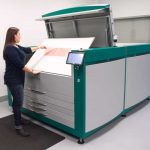It's easy to overlook a small plate problem when it isn't causing a glaring issue later in the printing process. Catching these small signs early can save a lot of headaches down the road...
- Floor thickness is set by the washout, not the back exposure time.
- While the plate relief may be correct, the back exposure time is too short, causing inadequate curing of the face exposure to the floor of the plate. A properly cured floor should appear smooth and even, and have a variation of less than 0.002" across the plate. Conducting a washout test in conjunction with a back exposure step test can verify that the correct settings are being used.
- Extending exposure times to compensate for weak UVA bulbs.
- While this can work to some extent, weakened UVA bulbs are not as effective for curing photopolymer. Once bulb power drops below 10-12mW, there is a considerable loss in plate quality. This mainly effects the face exposure, since high intensity UVA is much more effective for holding fine details such as screen work and fine lines. Longer exposure times at lower intensities can yield broad shoulders and filled in reverses, leading to fill-in and excessive dot gain. If you can't remember the last time the UVA bulbs were replaced in your exposure unit, it's probably time to change them out for a fresh set.
- Shortening drying time to get a solvent-processed plate out more quickly.
- Solvent plates absorb processing solvent and swell as a side effect of the washout process. These plates must be thoroughly dried in order to remove the solvent and decrease the swelling of the plate before finishing. When plates are removed from the dryer before completely dried, they will remain at the thicker gauge, causing registration problems (elongation) on press. Thin lines in the artwork can also appear wavy instead of straight if plates are not allowed enough time to dry.
- If you need your solvent plates to dry faster, explore alternative washout solvents such as HPS-XO (available from APR). New advancements in plate solvents yield higher quality plates in less time, due to their low plate swell characteristics. Drying times can be reduced by as much as 50%.
- Storing or stacking plates without protection between them.
- Proper storage is critical to getting the most out of your plates. It's easy to toss the plates into a file folder, but taking a few extra steps can greatly improve their useful life.
- Keep a protective layer between plates stored together, such as foam sheeting, or parchment paper. Plates stored back-to-face can stick together or leave impression damage when separated.
- Store plates in a light-proof enclosure, such as black plastic or heavyweight envelopes. Even normal room light can expose plates over time, causing cracking and chipping problems.
- Keep plates away from ozone-generating areas such as electrical equipment, air conditioners, and platemaking equipment (UVC/detack light generates ozone).
Following these simple tips will keep your plates working at their peak performance! If you have any questions regarding platemaking or other flexo topics, contact me at [email protected].
All Printing Resources carries a full line of Platemaking Supplies and Equipment. Click here to learn more.

